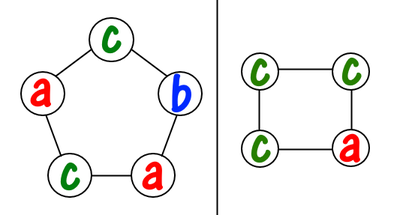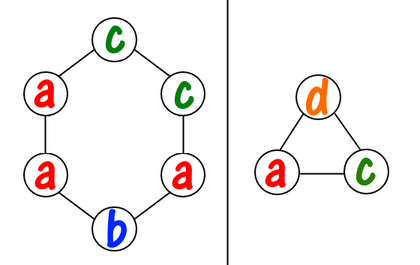Preparando MOJI
The store sells $$$n$$$ beads. The color of each bead is described by a lowercase letter of the English alphabet ("a"–"z"). You want to buy some beads to assemble a necklace from them.
A necklace is a set of beads connected in a circle.
For example, if the store sells beads "a", "b", "c", "a", "c", "c", then you can assemble the following necklaces (these are not all possible options):

And the following necklaces cannot be assembled from beads sold in the store:
 The first necklace cannot be assembled because it has three beads "a" (of the two available). The second necklace cannot be assembled because it contains a bead "d", which is not sold in the store.
The first necklace cannot be assembled because it has three beads "a" (of the two available). The second necklace cannot be assembled because it contains a bead "d", which is not sold in the store. We call a necklace $$$k$$$-beautiful if, when it is turned clockwise by $$$k$$$ beads, the necklace remains unchanged. For example, here is a sequence of three turns of a necklace.

In particular, a necklace of length $$$1$$$ is $$$k$$$-beautiful for any integer $$$k$$$. A necklace that consists of beads of the same color is also beautiful for any $$$k$$$.
You are given the integers $$$n$$$ and $$$k$$$, and also the string $$$s$$$ containing $$$n$$$ lowercase letters of the English alphabet — each letter defines a bead in the store. You can buy any subset of beads and connect them in any order. Find the maximum length of a $$$k$$$-beautiful necklace you can assemble.
The first line contains a single integer $$$t$$$ ($$$1 \le t \le 100$$$) — the number of test cases in the test. Then $$$t$$$ test cases follow.
The first line of each test case contains two integers $$$n$$$ and $$$k$$$ ($$$1 \le n, k \le 2000$$$).
The second line of each test case contains the string $$$s$$$ containing $$$n$$$ lowercase English letters — the beads in the store.
It is guaranteed that the sum of $$$n$$$ for all test cases does not exceed $$$2000$$$.
Output $$$t$$$ answers to the test cases. Each answer is a positive integer — the maximum length of the $$$k$$$-beautiful necklace you can assemble.
6 6 3 abcbac 3 6 aaa 7 1000 abczgyo 5 4 ababa 20 10 aaebdbabdbbddaadaadc 20 5 ecbedececacbcbccbdec
6 3 5 4 15 10
The first test case is explained in the statement.
In the second test case, a $$$6$$$-beautiful necklace can be assembled from all the letters.
In the third test case, a $$$1000$$$-beautiful necklace can be assembled, for example, from beads "abzyo".